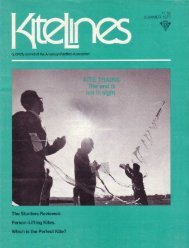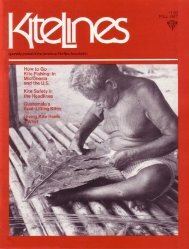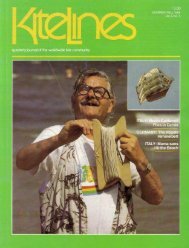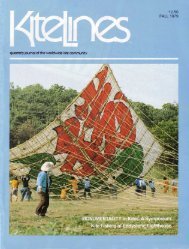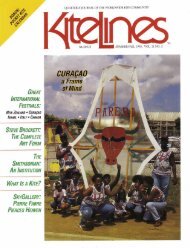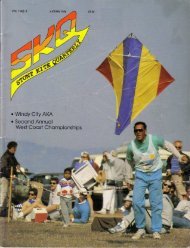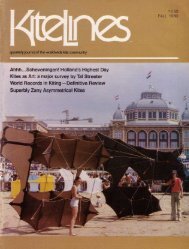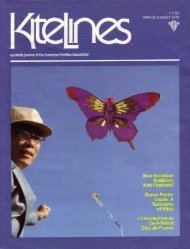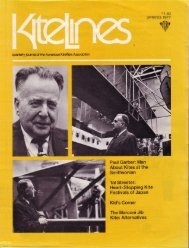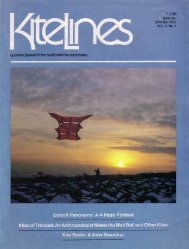Kite Lines - Vol.3 No. 1 - KiteLife
Kite Lines - Vol.3 No. 1 - KiteLife
Kite Lines - Vol.3 No. 1 - KiteLife
- No tags were found...
You also want an ePaper? Increase the reach of your titles
YUMPU automatically turns print PDFs into web optimized ePapers that Google loves.
What's New. . . Continuedkites' directional stability and lift efficiency.These major components are ofmolded or die-cut plastic foam of the styrofoamkind-moderately dense and moderatelyrigid . Minor fittings and pivots areingeniously-tooled, injection-molded thermoplasticmaterial . Metal pivots wouldhave been better . As is often the case withmass-produced kites, this one's performanceis not up to the level of quality thata careful individual designer and makernormally realizes from his or her efforts .However, I'd recommend Roll-O-<strong>Kite</strong>to anyone who'd like to get acquaintedwith the genre . Made to a larger scaleabout1 .4 times larger-and provided withsuper-proportionally greater diameterendplates, an efficient fat-foil form, pluscareful workmanship and balance, thiskind of rotor kite is capable of outstandingperformance-and it needn't have itsclean design cluttered with flag or handkerchiefstabilizers, either!SAM DA VINCI'S UFOManufactured by Bargain Basement, $6 .00ppd ., the "Unconventional Flying Object"rotor kite utilizes conventional geometrycommon to the center-stabilizer kind ; i .e .,a more-or-less elliptical planform liftingbodywhich rotates about its horizontalor long axis and which incorporates witha centrally fixed stabilizer disk whoseplane contains the short axis of the ellipseand is perpendicular to the long, rotationalaxis .The sample UFO consisted mainly oftwo '/2-mil membranes of tough, Estar® -type thermoplastic material cemented toperimeters or surrounds of formed translucentImperial Eastman Nylo-Seal® tubing,33-SN-3/16 . The two major componentswere joined together at their commonintersection by flexible transparent adhesive-tapehinges which permitted the kiteto be collapsed and packed flat in anenvelope for shipment . The only assemblyoperation required to prepare the UFOfor flight was that of erecting the stabilizerdisk perpendicular to the elliptical liftingbody and securing the configuration withfour "guide lines" (actually stays) whichwere slivers of peel-and-apply sticky tape .Experienced users of rotor kite airfoilsof high efficiency may well wonder whythe essentially flat tympanous pellicle airfoilof the UFO can be expected to autorotateand subsequently enjoy lift fromMagnus forces . The fact that a flat airfoilis indeed capable of rotating in a fair windand therefore can enjoy lift forces, albeitinefficiently, deserves brief discussionuninhibited by sesquipedalian, scholarlyanalysis of the phenomenon . Colorfully,capriciously and with good cause we maycall it "The Bull-roarer Effect ."Fliers youngerthan 60 may notremember that, toomany generations ago,bull-roarers were currentas popular, simple, homemadetoys . A proper, functionalbull-roarer consistedof little more than a long,thin slat of wood-oftenpurloined from an opportuneshutter or windowblind-to which a lengthof string was tied througha small hole bored nearone end . The child's dutyand-pleasurewas to whirlthe slat rapidly in a horizontalcircle-plane above hisor her head . As the whirlingcommenced, magic happened :the slat acquired rapid rotation about itslong (string) axis and emitted a mostgratifying, satisfying, fluttery roar of amagnitude guaranteed to prod prostrateparents from their postprandial pallets!More magic : As the slat assumed respectablyhigh rotational velocity, noticeableMagnus forces came into play ; prevailedover resistant centrifugal force ; andthe nearly plane, circular path initiallytaken by the slat and its string evolvedinto one of two possible conical pathenvelopes: base-up position-slat high ; orbase-down position-slat low . Either positionwas determined by the rotationalsense of the slat .Since the sophistications of swivelsseldom were savored in the Olden Days,guess what happened? You are right .After being twisted many turns, the stringstored up sufficient torque energy torevolt (if it didn't break) ; it overcameoriginal rotational inertias and obliged theslat to rotate a while in the opposite sense .As a consequence, the bull-roarer slatalternately cycled in high-low-high-lowpaths . These oscillations continued aslong as youthful energy and exuberancepersisted .END OF DIGRESSIONWe resume discussion of the UFO . Thebridle is the usual V-shape ; about 31 incheson each branch ; heavy monofilament witha knotted loop-bight at the junction ; eachbranch extremity is tied to one hole in atwo-holer shirt button (!) ; the remaininghole in each button serves as a pivot bearing. Other pedestrian items are : truncateddressmaker pins as pivots ; pherical plasticbeads as friction-reducing pivot spacers .Originally, the kite's mass imbalanceor vestigial geometrical unsymmetrycaused it to fly in a wing-low attitude .The condition was corrected by shorteningthe bridle branch attached to thelowside pivot .This rotor kite has no "top" or "bottom"as do its brothers which sport curvedasymmetric airfoils . Therefore, on anygiven flight attempt, the current "up"side should move in rotation away fromthe flier, or downwind . One would thinkthat the kite at random would commencerotation in either sense when committedto ample ambient airflow-fifty-fifty,heads or tails . However, the UFO Trollsmust have stacked the deck : the test-kitepreferred to commence turning in thedesired sense four times out of five!Simple but ample instructions packedwith the kite included a phrase that someof us elder fliers may consider to be eviladvice : "To fly, stand with your back to



